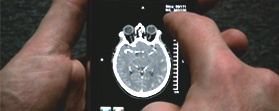 If mobile health hasn’t officially arrived in clinical settings yet, here’s another indication that it’s almost there: Physicians should be able to diagnose a stroke just as well with an iPhone app as they can with a fixed workstation. The medical literature now says so.
If mobile health hasn’t officially arrived in clinical settings yet, here’s another indication that it’s almost there: Physicians should be able to diagnose a stroke just as well with an iPhone app as they can with a fixed workstation. The medical literature now says so.
A study just published in the Journal of Medical Internet Research found that the Resolution MD app from Calgary Scientific is between 94 percent and 100 percent as accurate as medical workstations in helping physicians read CT angiograms to detecting abnormalities in blood vessels that signify acute ischemic stroke.
“We were pleasantly surprised at our ability to detect subtle findings on the CT scan, which are often very critical in patient management, using this software,” the study’s designer, Dr. Mayank Goyal, research director in the University of Calgary Department of Radiology, says in a news story released by the Canadian university. Goyal is a Calgary Scientific shareholder, and Calgary Scientific co-founder Ross Mitchell of the university’s Hotchkiss Brain Institute is the paper’s corresponding author.
Resolution MD, which gained Health Canada approval in April 2010 and is currently under FDA review in the U.S., addresses the problem of transmitting huge DICOM images—often hundreds of megabytes each—to smartphones by rendering the images on a server before transmitting files to mobile devices with “https” encryption. “Advanced visualization methods not possible on the remote device, such as three-dimensional volume rendering, may be used to generate frames for remote viewing,” the study says. “The smartphone client-server teleradiology system appears promising and may have the potential to allow urgent management decisions in acute stroke.”
The app is available for both Apple iOS and Android platforms, though the study only used iPhones.
For the study, the researchers transmitted images over an 802.11g Wi-Fi network at a rate of 14 frames per second since a 3G cellular connection only can support 1 to 4 frames per second, according to the paper. Newer 4G technology should solve that problem. “We estimate that the higher bandwidth of these new cellular networks should allow 10 to 15 frames per second to be delivered to smartphones,” Mitchell, Goyal and their collaborators write.
The study has a number of limitations, which the University of Calgary team acknowledges by suggesting additional research. Only two neuroradiologists read the images on iPhones and they only made retrospective diagnoses in a research environment with access to a reliable high-speed network. The study pool was rather small and the researchers did not monitor the rate of compression of JPEG images to see if the images sent to the phones were within accepted medical guidelines for image compression.
“In the future, a larger prospective study performed by physicians on-call working under clinical constraints will be required to demonstrate the clinical utility of our system. We would also like to test the potential usefulness of our system for other acute conditions like renal colic, skeletal trauma and acute coronary disease,” the paper says. “We would also like to test the potential usefulness of our system for other acute conditions like renal colic, skeletal trauma, and acute coronary disease.”
















